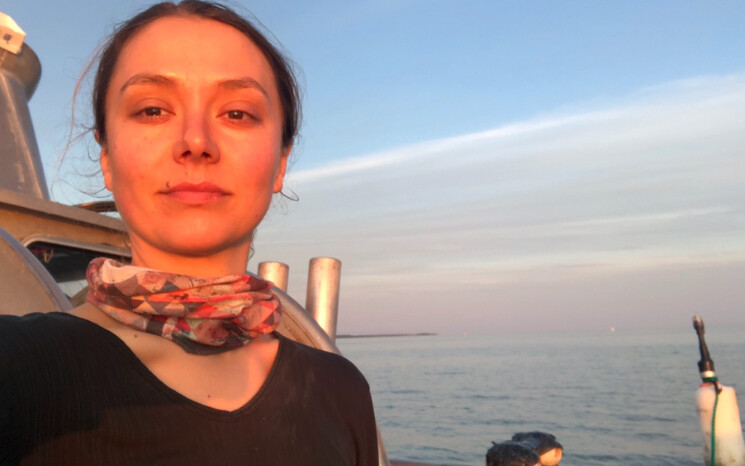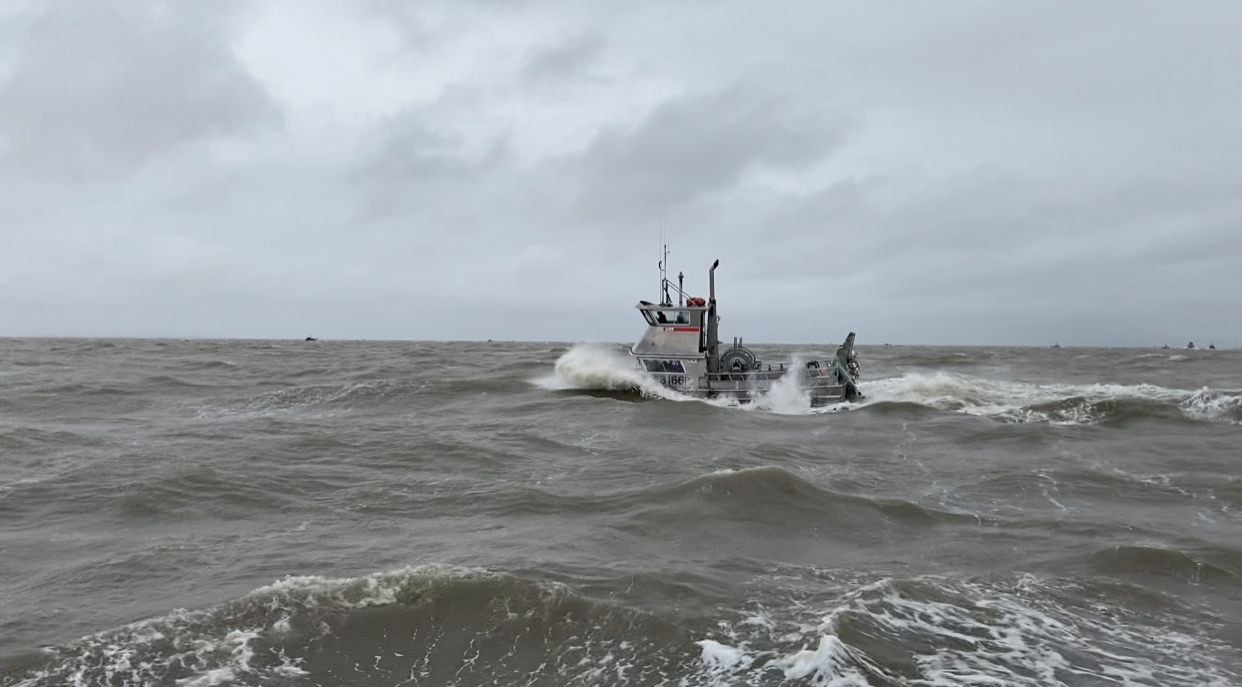As I looked out at the storm from the safety of my captain’s couch, I could hear my phone buzzing. My dad’s texts came through all at once.
Have you seen the fish predictions for the Nushagak District?
You’re gonna be fishing in the right place this season!
Looks like nasty weather for an opening day!
Have you been reading about what’s going on right now in Bristol Bay?!
He was following Dillingham radio station KDLG’s news reports, seeing ambitious fish predictions for the river district where I would spend the 2021 season. After two weeks of nonstop pre-season boat tweaking and net repair, we felt prepared. Ready or not, it was almost time to untie from the dock and head out into the bay. The season was here!
As a kid growing up thousands of miles away in Southeast Alaska’s small town of Sitka, everything I heard about Bristol Bay seemed in relation to Pebble Mine: the region’s epic wild salmon runs; the risk of their demise.
I’d seen protests against the proposed copper, gold, and molybdenum mine in the news, No Pebble Mine stickers on our friends’ cars and water bottles. I’d heard my parents’ impassioned concerns while we were hook-and-line fishing for coho salmon off the coast of the Tongass National Forest.
I remember my dad explaining, “The earthen dam they plan to build will hold back an enormous lake full of millions of gallons of toxic sludge. That area of Alaska has a lot of earthquakes, so a dam could easily fail and ruin the biggest and most valuable salmon run in the world! Pebble lies and says it will be safe, but they don’t know and they don’t care!” He went on to say that he’d read a study that even a small, trace amount of copper in the natal stream will interfere with a baby salmon’s directional sense and their ability to evade predators.
“No! Why would anyone try to do that?” As a child, the thought of it made me feel claustrophobic. I could feel what it would be like to lose my home, to get sick and die because what once was a pristine natural paradise was now a toxic waste dump.
Twenty-five years later, I was amazed to actually be in Bristol Bay, about to experience those legendary runs for myself. As much as I had been intimidated by the Bristol Bay driftnet fishery, I’d long felt drawn to it.
Upon meeting my captain, Katherine Carscallen, a third-generation Nushagak River fisherman, I was surprised to see we were the same age (early 30’s) and size, standing at 5’ 4.” I soon found out through handing her tools in the engine room, as well as overhearing her lengthy conference calls with the United Tribes of Bristol Bay, that she had the type of extreme competence and community engagement you only find in rural Alaskan fisher-people.
In overhearing her calls, I was struck by the solidarity of the people who have been successfully advocating to keep Bristol Bay as it has always been– a pure, wild, self-sustaining watershed, the most abundant salmon producing region in the world: fifty percent of wild-caught salmon on the planet.
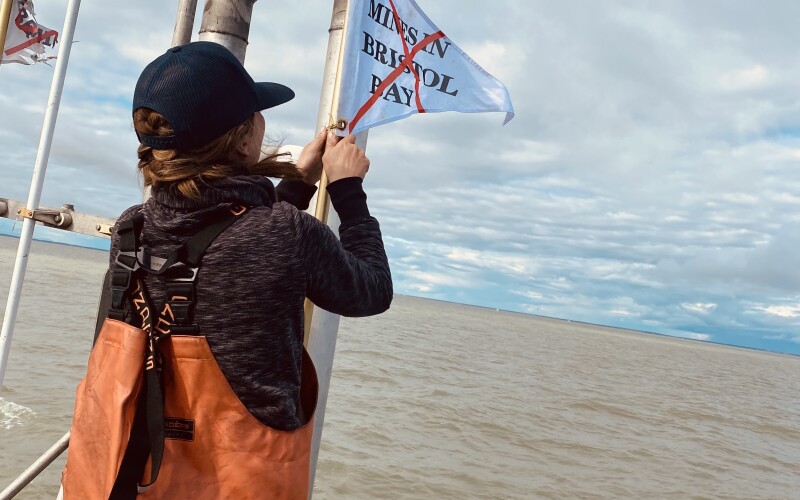
The leaders in the fight to protect Bristol Bay are the Yupik, Dena’ina, and Alutiiq tribes, thriving salmon-based cultures for whom salmon are essential. The tribes have stewarded the region since time immemorial. For almost two decades, members of the Bay’s thirty-one federally recognized tribes have shown up in courts and Capitol hearing rooms, protesting a mine that would devastate every facet of life here. They have a lot to lose. With no separation between the health of the ecosystem and the health of their people, their survival – cultural and literal – teeters on the development or denial of Pebble Mine.
Other advocates standing shoulder to shoulder against the contentious mine are sportsmen and women, tourists, anglers, hunters, lawyers, environmental organizations and commercial fishermen. People from a wide range of political and socio-economic backgrounds have come together to fight Pebble Mine, drawn by a shared mission of protecting the salmon and wildlife habitat. This collective opposition against the proposed mine has strengthened and connected communities, issuing a rallying cry to support the land, air, and water we love and depend on.
OPENING DAY BRISTOL BAY, JUNE 21, 2021
When our 32-foot bowpicker nosed out of the harbor, I felt the force of a powerful wind buffeting my rain gear. In the short hour-long run to our fishing grounds, Katherine’s warm living room seemed another world away, a fleeting and distant memory. I longed to be bundled up on my couch, numbly pressing ‘next episode’ on my borrowed Netflix account with a warm pan of brownies on my lap — a habit I’d adopted to get through covid times.
As we neared our destination, the wind on our stern was blowing hard, 25 to 30 knots. Soon we found ourselves surfing down the face of eleven-foot waves, brown with river-silt. I glanced at my crew members — Ashley Miller, a 26-year old Dillingham local, and Jesse ‘Oly’ Oliver, a sturdy farmer and social worker from Vermont.
They both looked shocked and somber, gripping the rails. I thought to myself, “Are we really going to fish in this shit?”
Growing up commercial fishing with my family in Southeast Alaska, we never knowingly went fishing in a gale-force storm, even if it meant missing out on a hot bite. But things in Bristol Bay, inland of the Bering Sea, are different. There are no protected anchorages to tuck into like there are in Southeast. The bare tundra terrain and strong river currents colliding with massive tides make for exposed coastline and very little protection from the natural world. People are tougher; fishing is more competitive. The peak season is short with huge financial rewards, so fishermen feel the need to get out there, even if the weather isn’t good.
Of course we were going to fish in this shit.
“Okay, throw the buoy over and set the net!” Kat yelled through the howling wind.
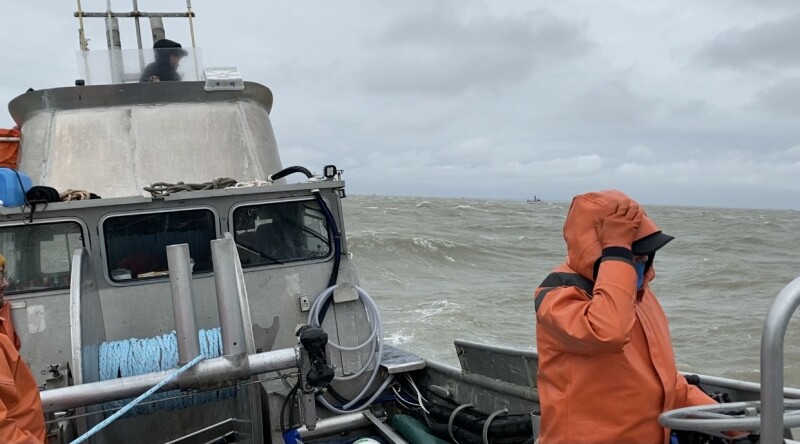
Even as my mind questioned whether she’d turn the boat back around (maybe we could spend one or two more nights on land, wait out the storm, tucked into our warm bunks?), I watched the gear bounce in the water. Suddenly our commitment was real.
I heard the radio from the cabin. Eric, a robust and free-spirited, long-haired Californian on another boat, yelled, “This is looking good. We’re loading up!” Another group member, the eldest at 75, said, “Look at this weather. You know what that means, the salmon are about to show up! Not bad for an opening day.”
After four hours of fishing, we’d caught a few thousand pounds, a pretty good catch rate for the first opening. This was a foreshadowing of the record-breaking abundance soon to follow. It also meant the season had officially begun and there would be no turning back! No seeking calmer waters or enjoying creature comforts. For the next month we would be at sea, leaving behind the lush colors of a Tundra Summer and heading out into the gray-brown abyss of the Bay. We would be cold, damp, physically fatigued, achy, cranky and sleep deprived. We would also be alert with adrenaline, in tune with the elements, animated with sea breath.
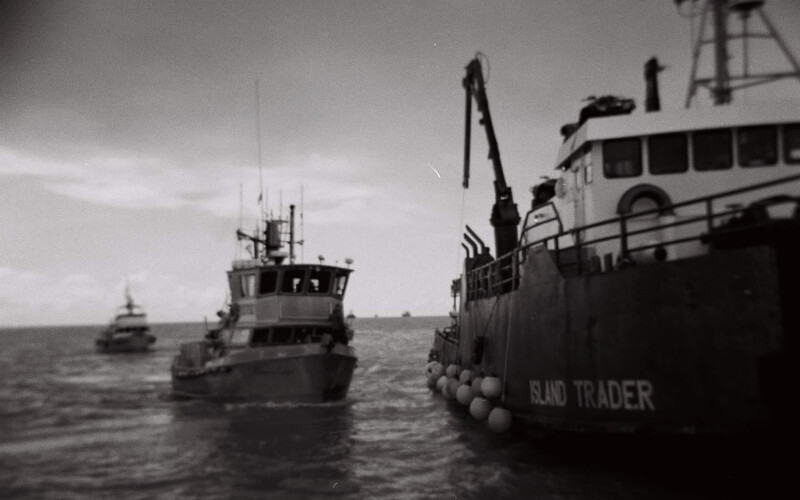
After each opening, we headed to the tender to sell our catch. Our boat, dwarfed by the buyer boats’ large hulls, bounced and banged against their rails in the seas. We communicated by screams and hand motions over high winds and loud machinery.
We each kept a knife handy; Kat repeatedly told us, “Be ready to cut our tie-up line at all times.” We’d seen what could happen if one line flung loose while we were still connected on the other end. Boats had flipped from less weather than we were in.
The tender captain would reach over his guardrail and hand Kat a fish ticket to fill out. After our catch was weighed, the tenders submitted paperwork accounting for every fish harvested, including their precise location– data shared in real time with fishery biologists to determine how to regulate the fishery for future healthy salmon runs. The salmon sold to the tenders were then brought to a processing facility on land and shipped to domestic buyers, such as Costco, to feed consumers seeking sustainable, wild Alaskan fish.
It was a painful start to the season. The unrelenting rough weather and fumes from the solvents and hydraulic oil smoking off the engine nauseated us.
Six days into the season, on one of the darkest and stormiest nights, we heard through the radio that two boats had sunk with rumored loss of life. There was another rumor that our boat, the Seahawk, had sunk. We received over twenty satellite phone messages from concerned loved ones the next day. The idea sent a chill down my spine and made me realize that it could have just as well been us. Death, knocking on our door.
Every time I went to tie up our stern to a tender I would hold on for dear life with one hand and tie the massive line around our cleat, knowing that if my supporting hand were to slip, I would get swallowed up by the brown churning water and join the thousands of fishermen lost at sea.
”I could die doing this,” I thought, repeating the words like a mantra in hopes that saying them would keep me alert enough to make smart decisions amidst extreme sleep deprivation.
“This season is intense. It feels so dark, hearing about boats going down right around us,” I vented to Ashley, a wave of sorrow washing over me for the potential lives lost.
“Yeah, this does feel really dark. I’ve also never heard about this many deckhands quitting so early in the season,” she replied.
Just as Ashley said that, we heard our radio crackle.
“Well, our new deckhand just quit. I had such a good feeling about him - strong, young guy in school to become an engineer,” a captain said. “I explained to him the season is short and he just needed to get through the next few weeks.
“I told him he’s making $5,000 a day and he said, ‘No amount of money can convince me to stay.’ Wow, it’s so weird, apparently he’s not driven by money,” the captain concluded, perplexed.
Ashley said, “You know, no matter what happens I wouldn’t even think of quitting and leaving Kat without a crew.” I agreed, bonding over our commitment to be there to the end. We were among the lucky few who had a friendship with and sense of loyalty to our captain and crew.
Unloading that night, I asked the tender captain if he knew what had happened to the boats that went down. He didn’t know any details, but said in a morose voice, “This year reminds me of 2018. It was stormy like this and so many boats went down that year.”
He spit his chew over the rail and looked me in the eye. “Bristol Bay eats people.”
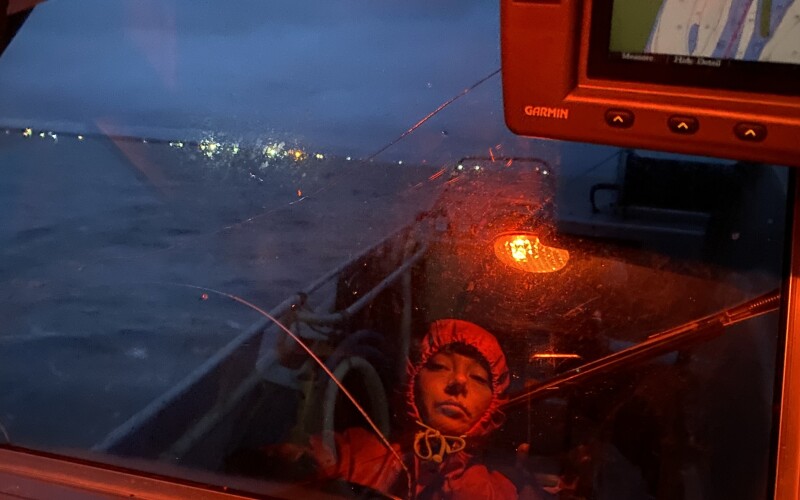
Was it morning or was it night? They blur together in the land of the midnight sun, where summer months provide twenty-one hours of daylight. Oly made us a hearty meal of eggs, bacon and cheesy tortillas. We ate staring glumly at the motionless cork line. Nothing, not a single cork bobbing to signify a fish struggling to free itself from the nylon mesh. Is it going to be a failed run? Are they getting them somewhere else? If so, where?
In a season that lasts only five weeks, it would be almost impossible not to catch FOMO: Fear of Missing Out. Especially the captain, the person responsible for the many decisions that go into the process of filling the fish holds. As crewmen, our job is to handle tasks on the deck like setting and picking fish out of the net. We want those fish, we want them bad, but the “how to get them” is not in our job description.
Suddenly, the group radio speaker crackled with words that shocked and galvanized us into action. “Get over here, like now.”
A tight-knit bunch of eleven captains, the so-called ‘code group,’ worked together with the shared mission of catching hundreds of thousands of pounds of sockeye salmon – and staying alive so everyone returned safely home to their families after the short and grueling season. They used the radio to communicate how much they were catching, weather and tide conditions, how much space there was between them and other boats, invaluable mechanical repair advice, as well as encouragement and playful shit-talking banter – a hive-mind of highly skilled mechanics and specialized fishermen. The kind of group many fishermen longed to be part of because in the great expanse of the Bay — as in the great expanse of the world — working together ensures not only your success, but your survival.
We picked our net as rapidly as possible, which happened to have only one sockeye in it, and sped off to join another captain nicknamed Mogley, our nervous systems on high alert. We could see splashing all along the cork line as we set. Within five minutes of putting out the 1,200 foot-long net, the Styrofoam corks that keep the net afloat began to sink. Within fifteen minutes, the whole thing had disappeared beneath the waves completely – weighed down by a giant school of sockeye salmon.
We froze in shock and awe, witnessing the sheer volume of salmon, masses of schooling sockeye moving together like a water dragon. I looked at Kat’s face to determine how concerned I should be. She was staring at the water with wide eyes, relaying what she was seeing to her code members on the radio. Her voice was thick with emotion. “Thanks for calling me over here. We’re surrounded by an army of salmon. I ’ve never seen anything like this!”
Flashing back to our biggest previous haul, I realized we deckhands needed to kick into gear and take care of our bodily needs immediately - use the bathroom, change into breathable clothes under our raingear, hydrate, stash the impossibly blue bottles of Gatorade on deck for easy access and stuff granola bars into our mouths.
Despite the cold weather, Oly stripped down to just boxer shorts under his full set of raingear, knowing how physical and sweaty the work ahead would be. My stomach turned as I thought about how long it was going to take. The sunken gear meant we would need to move quickly, releasing salmon for up to six hours, making sense of a tangled net, powered only by caffeine and adrenaline. It meant no time to take a break, not even to pee.
“This will be a test to see what our crew can handle together,” I thought.
Not only did we need to have our net aboard by the time the fishery opener ended in six hours, the tide was on the flood and moving our boat swiftly toward the regulatory line of where we were allowed to fish. Crossing “the line” meant the fish cops would not only confiscate all the fish we had laboriously picked out of our net, but also our captain would be slapped with a huge fine for breaking the law, a future court date and a violation on her record. Basically, we needed a miracle in order for this to end in our favor.
As we pulled in the buoy at the start of our net, Kat said, “I know you guys know this and I’m sorry to have to say it, but I need you to work as fast as you can and don’t stop for anything.”
For the next four hours, Kat steered and pulled in our net as us deckhands were fully immersed in our specific jobs: untangling the fish, cutting their gills with sharp knives so the blood would run out of their flesh, sliding them into tanks of ice-cold water. We drifted dangerously close to a boat called Redrum (murder spelled backwards). The captain threw up his hands and screamed, “Where’s your net?!”
Kat said, “It sunk! It’s floating under yours and I'm not gonna tow it!” He responded by throwing his head back in maniacal laughter.
I knew that if our net were to tangle with his we would have bigger problems, as we had a violent encounter with him last season, but we continued to drift past him and many other fishermen with our gear floating under the other boats.
Two hours into our set, Kat called out on the radio. “Well, there’s no way I’m getting these fish aboard in time without getting a ticket. It’s too dangerous to round-haul [pull the whole net on deck, fish and all] the end of the net in this weather with our starboard list and the front holds already so weighted down.”
Three of our other group members had already called for help. Another captain, John, responded, “I can’t help you with all those boats so close around you. I’m gonna’ go help Mogley and then I’ll stop by and see where you’re at.” John was Kat’s childhood friend. When they were growing up together in Dillingham, their parents would alternate childcare on land to take care of them so both families could keep fishing.
Resigned to the fact that she would get a ticket, Kat said, “Okay, we’ll just get as many of these fish aboard as we can.”
We kept working as fast as possible. Three hours later, I saw John whip his aluminum boat close to us, attempting to drop off his tall blonde Viking of a deckhand. As John nosed his bow up to us, the Viking carefully navigated an eight-foot lurching drop between each swell that rammed our two boats together and stepped gracefully onto our stern. He worked alongside us, mentioning he was a bear hunting guide from Sitka and captain of his own Bristol Bay driftnet boat. That explained his nonchalant demeanor in the midst of chaos. Four minutes before the fishery closure and 100 feet shy of drifting over the line, our net’s final corks came aboard, salmon overflowing the holds. Our miracle had indeed shown up.
As we motored to our tender boat to sell and offload the fish, the boat was so heavy that we rode dangerously low in the water, brown waves washing over our decks. We caught more fish that day than Katherine had ever caught in her eleven years captaining her own boat. The teamwork of our captain, crew, and code group turned what could have been her worst nightmare into her best day on record.
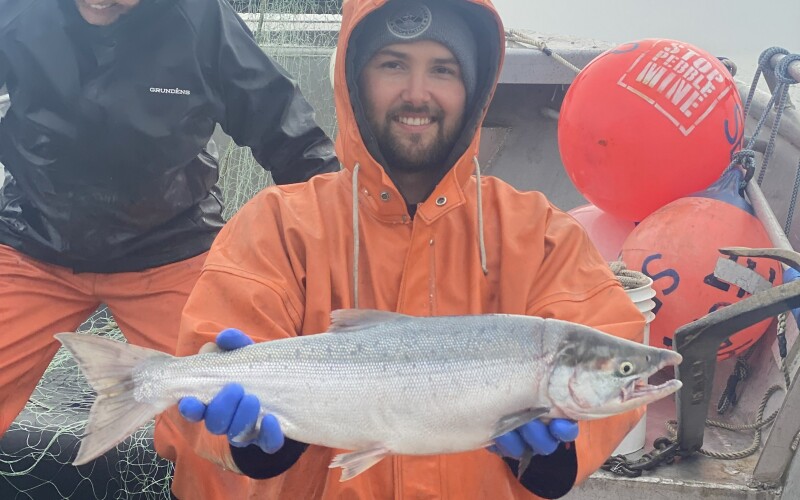
The radio crackled, an official voice beaming. “Due to high numbers of escapement in the Nushagak River counting towers, Alaska Department of Fish and Game (ADF&G) has opened up driftnet fishing in the district to a 24/7 schedule.” A world-class model of sustainable fish management and conservation, ADF&G determines when to open the fishery based on salmon escapement, a term used in fishery science to mean the amount of salmon making it up the rivers to spawn and complete their life cycle.
Fishery biologists confirm escapement goals are met before the fishing schedule is set, ensuring a healthy returning population for future generations. In massive salmon returns, if the escapement is set too high or if too many salmon escape the nets of fishermen, they can overcrowd the river. In cases of over-escapement, the first eggs laid in the river gravel get dug up by new incoming fish, resulting in smaller fry and fewer survivors going out to sea and returning to spawn as adults. Biologists and fisher people work together, a science-based harvest collaboration, to protect the balance of just how many salmon the rivers can handle without being overwhelmed.
Selling our fish to the tender, we could breathe but one sigh of relief. We wouldn’t sleep or take a break. We would turn the boat around and do the same thing again. For the next three weeks we would fish around the clock with only stolen naps here and there. With our last brailer net bag of fish deposited to the tender, Kat headed up to the flying bridge, calling down to us.
“You guys have 45 minutes until we get to the fishing grounds. One of you can sanitize the holds; fill them with seawater and start cooling them. Let me know when the temp is thirty-four degrees. Two of you can sleep for thirty. Stay in your rain gear.” I followed Kat up to the helm. “Do you think this huge show of salmon will wake people up and remind them this area is worth protecting from mining?”
She looked exhausted and a little hopeful. “I hope so. We’ll find out in the next few months whether the EPA will follow through with their promise to protect Bristol Bay through issuing the Clean Water Act.”
2021’s sockeye salmon run in Bristol Bay broke the existing record. Over 65 million fish returned to the region. This was a natural abundance of epic proportions that filled the rivers, smokehouses, freezers, jars, and hearts of everyone involved. These catch records occurred with every escapement goal met, preventing overfishing and propagating future healthy runs. This coming season is predicted to break the record yet again!
Fishing season allows us to feel that strong net of support lifting us up and making us accomplish things we never believed possible. It’s an epic time of comradery, excitement, aliveness, sharing of stories and meals, empowerment, struggle, triumph, and hard lessons. We are all united in our intense love for the wild, salmon, and the freedom that the fishing lifestyle provides. There’s strength in knowing that we are in the same struggle and it feels more doable together – much like the fight to ensure the proposed Pebble Mine project never comes to be.
I can’t help but think that those salmon showing up so suddenly in such a massive school, in such solidarity, were sending us humans a message we can’t ignore. As with good art or poetry, it’s a message transmitted directly to the heart, that deep-down part of us that registers truth. Thinking back to my childhood and how horrified I was to hear about the proposed mine, and now, having experienced firsthand the bounty of wild salmon and the piercing beauty that is Bristol Bay, I see what’s at stake. I can’t unsee it.
****
As fishermen gear up for another salmon season, let us ensure we are informed and engaged in supporting the EPA to issue the Clean Water Act process to finalize protections for Bristol Bay and stop the Pebble Mine. Lend a hand and sign the comment letter online RIGHT NOW, asking the EPA to do a 404(c) to save these waters: https://bit.ly/EPAProtections2022
Nora Skeele grew up spending summers commercial fishing for salmon and halibut out of Sitka, Alaska with her family in their old wooden troller boat. Her deck-handing career has included 12 seasons hook-and-line trolling for salmon, 20 seasons long-lining for halibut, six seasons gillnetting out of Sitka and two years gillnetting in Bristol Bay. She is a writer, artist and designer in the off-season and enjoys splitting her time between Sitka and Hawaii, drawn to both places by the rich ocean-culture and pristine lands.
